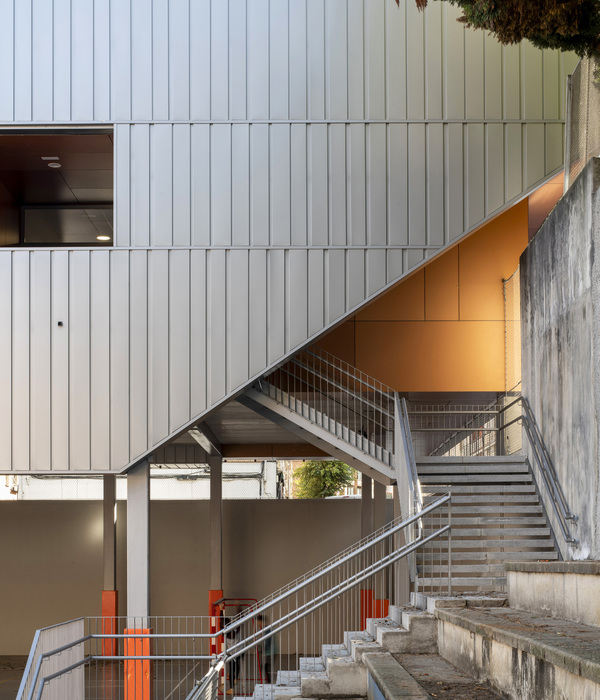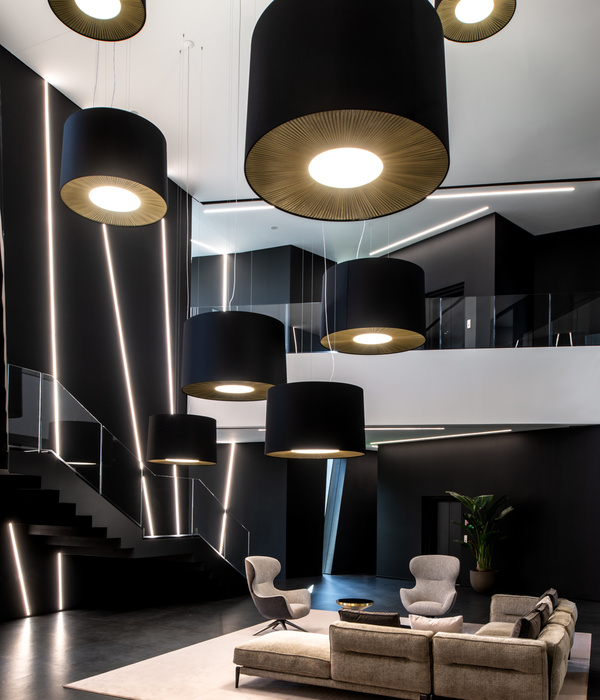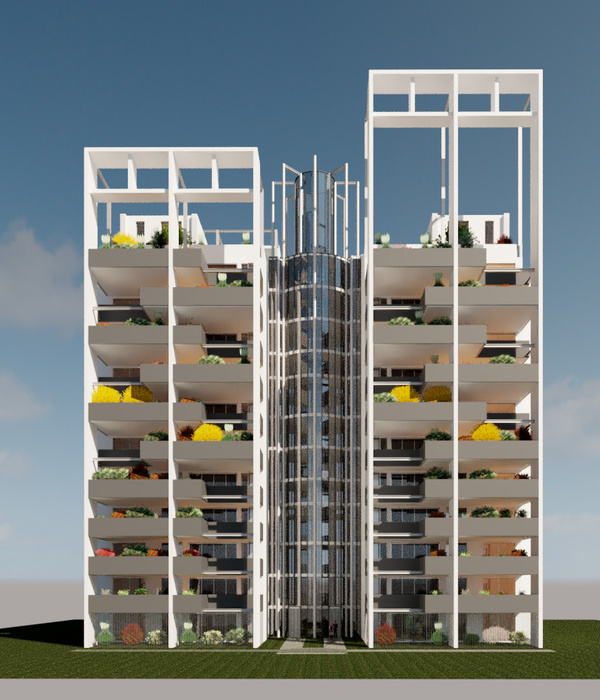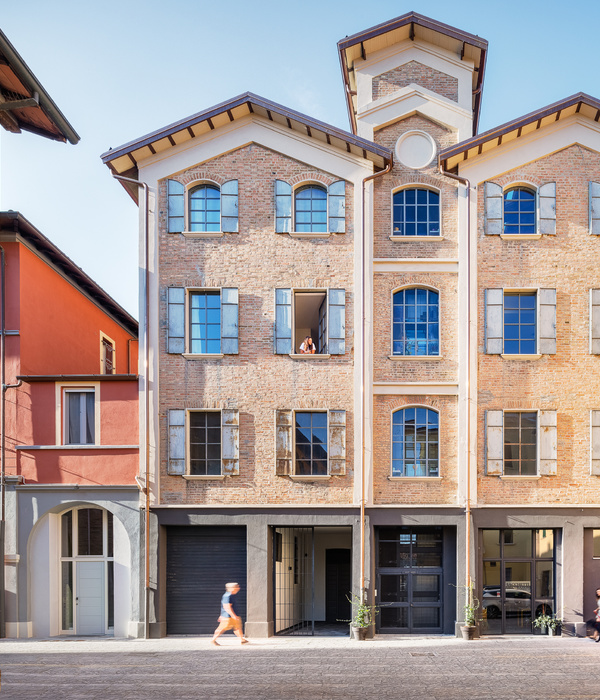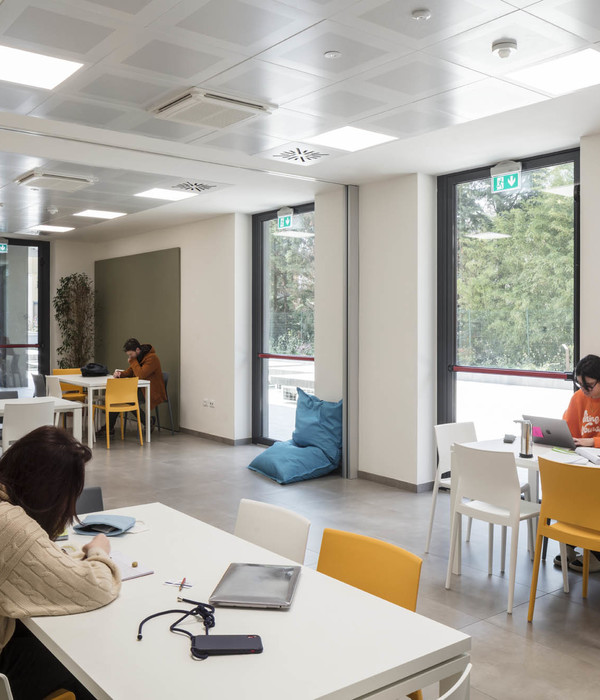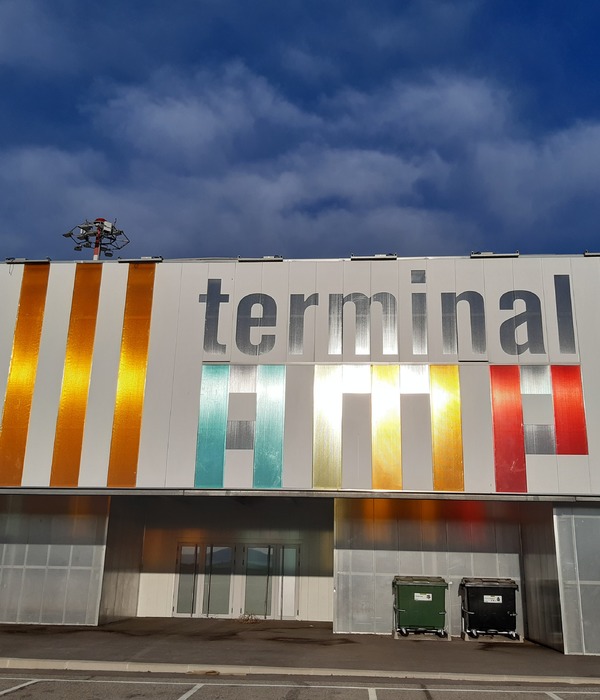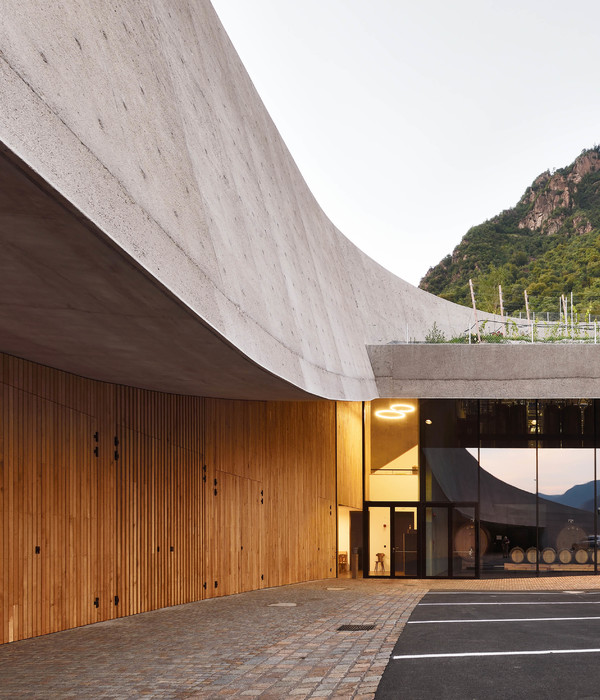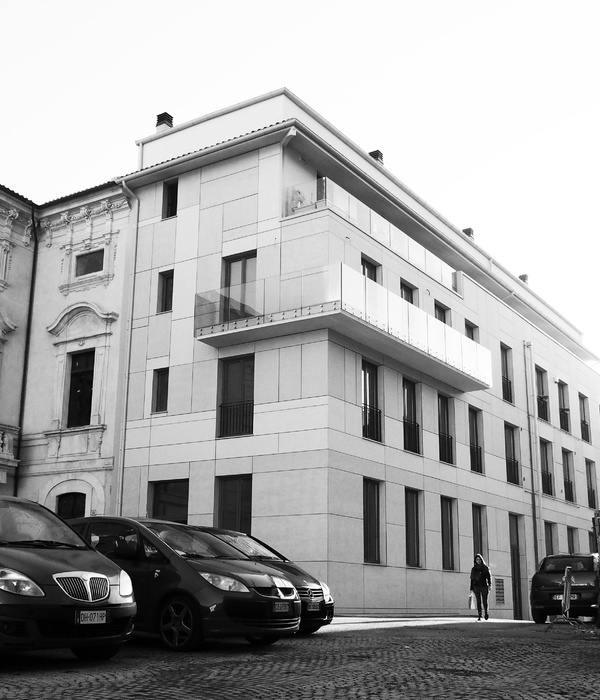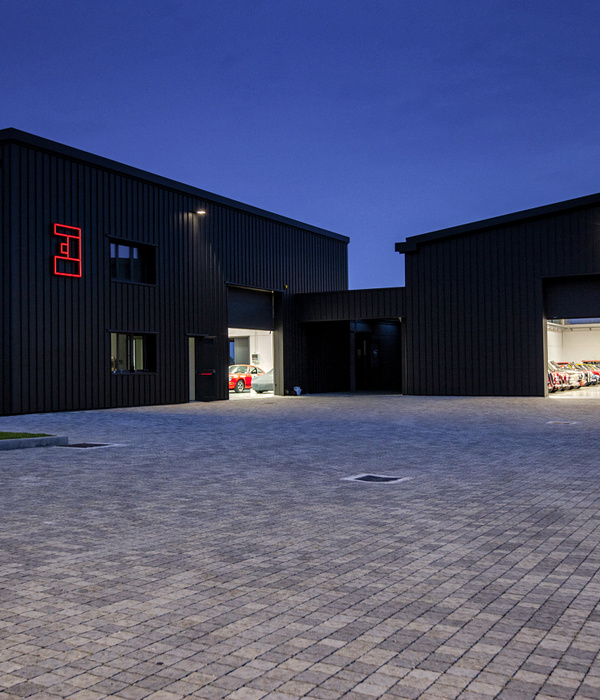正因为经历了从手工业空间到酒店功能的一个转变,建筑呈现出了一些超出既定类型教条的空间品质,比如公共空间宽大的屋顶尺度,一些房间举架高昂,另一些小巧精致,背后的故事所引发的空间逻辑耐人寻味。正是这些故事和曲折,也造就了一个有历史的建筑,种种可回溯和阅读的细节演化成了建筑的丰沛生命力。——李烨
Just because the building has undergone a transformation from a craft space to a hotel program, it presents some spatial qualities beyond the established type of dogma, such as the wide roof scale of the public space, the high lift of some rooms and the smallness and delicacy of others, the spatial logic triggered by the stories behind is intriguing. It is these stories and twists that create a building with history, and the details that can be retraced and read evolve into the rich vitality of the building. — Li Ye
▼项目概览,Project preview ©存在建筑-- 建筑摄影
2019 年初,小石村有三个新的项目策划启动,其中之一便是对溪边一个传统的豆腐作坊进行改造。初踏场地,因为还是 2 月份,周围树木的叶子基本都掉光了,河水也几近干枯成了小溪,但是场地内却有几簇茂盛的竹子从堤坝上探出头来,在周围略冷清的环境中显得格外充满生机。进入场地之前,需要穿过一座桥,而项目用地紧紧贴着桥的一端,处在一个非常重要的道路口。
经过实地调研后,发现基地不太稳定,处在一个相对陡峭的河岸边,且原建筑老化,局部河岸也有坍塌,综合成本、时间和安全上的考虑,最终决定把原建筑推倒进行重新设计。
At the beginning of 2019, three new projects were planned and launched in Xiaoshi Village, one of which was the renovation of a traditional tofu workshop by the stream. When I first set foot on the site, as it was still February, all the leaves of the surrounding trees had basically fallen off and the river had nearly dried up into a creek, but there were a few clusters of lush bamboo poking out from the embankment inside the site, which looked particularly vibrant in the slightly cold environment around. Before entering the site, you need to cross a bridge, and the project site is close to the end of the bridge, at a very important road junction.
After field research, it was found that the base was not very stable, in a relatively steep river bank, and the original building was aging, with the local river bank had collapsed, comprehensive cost, time and safety considerations, and finally decided to knock down the original building for redesign.
▼项目场地原状,Original project site status©时地建筑工作室
设计之初,村上给我们提出的要求,是希望把这里做成一个乡村特色美食产品的生产体验作坊。一方面通过豆腐、凉粉、麻饼等食品规范化、安全化的生产方式,把传统的乡村农产品推广到城市,从而带动乡村自身发展的需求;另一方面通过体验式的空间,包含亲子体验课程,乡味餐厅等,加深人们对于乡村传统农产品、美食的体验。
场地的高差、院中的 5 棵树、堤坝上长出的竹子、门前临溪后背靠路的特殊地形,以及河对岸的一片菜地民居,都给我们留下了深刻的印象。结合村上的需求,我们提出了“檐下百味集”的畅想,主要的生产以豆腐、麻饼和凉粉为主,同时也具备共享式的开放生产空间,展示空间,把传统的乡村赶集的场景融入到檐下的开放空间,打造一种特别的乡村赶集新体验。
At the beginning of the design, the request given to us by the village was to make this place a production experience workshop for rural special food products. On the one hand, through the standardized and safe production methods of tofu, cold noodles, sesame cakes and other food products, the traditional rural agricultural products will be promoted to the city, thus driving the demand for the development of the village itself; on the other hand, through the experiential space, including parent-child experience courses, the countryside flavor restaurant, etc., people will deepen their experience of the traditional rural agricultural products and food.
We were impressed by the height difference of the site, the 5 trees in the courtyard, the bamboo growing on the embankment, the special terrain with the stream in front of the door and the road at the back, as well as the vegetable field houses on the other side of the river. Combined with the needs of the village, we came up with the idea of a “Bacchanal under the eaves”, where the main production is tofu, sesame cake and cold noodles, but also has a shared open production space and display space, incorporating the traditional village fair scene into the open space under the eaves to create a special new experience of the village fair.
因为场地的地势是沿着道路一侧高,而临近溪边一侧低,所以整个建筑的功能布局,依据生产流线和休闲流线来划分,整个建筑的主入口,设置在靠近道路交叉口的位置,跟桥头保持了一定的距离。
Because the topography of the site is high along the road side and low near the stream side, the programal layout of the whole building is divided according to the production flow and leisure flow, and the main entrance of the whole building is set near the road intersection, keeping a certain distance from the bridge.
▼场地鸟瞰,Aerial view©存在建筑-- 建筑摄影
生产区打破原有的大空间形式,被划分成几个相对独立的小空间,以聚落的形式通过一条笔直的过道联系在一起。生产空间一共有两个,一个是麻饼生产区,生产环境相对干燥,比较满足作为长期参观展示的功能需求,所以位置靠近展示空间的主入口一侧,同时增加了员工的更衣区、公厕和接待用的前台空间。
The production area breaks the original large space form and is divided into several relatively independent small spaces, which are linked together in the form of clusters through a straight aisle. There are two production spaces, one is the sesame cake production area, production environment is relatively dry, and it meets the programal needs as a long-term visit and display, so the location is close to the main entrance side of the display space, and at the same time, the staff changing area, public toilet and reception reception space are added.
▼建筑空间演变图,Building space evolution diagram©时地建筑工作室
另一个是豆腐和粉类加工生产区,因有很多用水的需求,为了方便后期的维护,就放置在生产流线的末端。而作为配套需求的物料储藏空间和包装空间则放置在两个生产区之间,处在临溪一侧的休闲空间流线上,这里也可以结合亲子体验空间的需求,作为扩展空间来使用。
The other is the production area for tofu and powder processing, which is placed at the end of the production line for the convenience of later maintenance because of the need for a lot of water. The material storage space and packaging space are placed between the two production areas, on the stream side of the recreational space, which can also be used as an extension space in conjunction with the parent-child experience space.
▼临溪一侧的休闲空间流线,the stream side of the recreational space©存在建筑-- 建筑摄影
休闲空间则沿着临近溪边的低地,围绕树院竹林在连续的屋檐下,顺着地形的变化而层层展开。入口处的展示大厅,主要作为产品展览、集市交流使用,闲时可作为开放空间给居民。靠着展厅的,是保留了原来豆腐坊五棵树的树院空间,是一个被展厅、生产通道和包装空间围绕的室外院落,带着场地原有的记忆,融合到新的建筑空间。
The recreational space is along the lowland near the stream, around the tree yard and bamboo forest under the continuous eaves, and unfolds in layers according to the changes of the topography. The exhibition hall at the entrance is mainly used for product exhibitions and market exchanges, and can be used as an open space for residents during leisure time. Next to the exhibition hall is the tree courtyard space that retains the five trees of the original tofu workshop, an outdoor courtyard surrounded by the exhibition hall, production channels and packaging space, which carries the original memory of the site and blends into the new architectural space.
▼室外树院,outdoor courtyard©存在建筑-- 建筑摄影
再往一侧走则是比包装区低了一层的亲子体验空间,也利用了包装区的半地下空间,给亲子体验区增加了小厨房和公厕。因为这层空间更加临近河面,所以扩大了檐下的平台,伸向河面,整个平台深度达到了 5 米,可以作为亲子体验区的外部延展空间来使用,也可以供一般居民和访客驻足停留,听听脚下的流水声,看看对岸的袅袅炊烟。
Further to the side is the parent-child experience space, which is one level lower than the packaging area. The semi-underground space of the packaging area is also used to add a kitchenette and public toilet to the parent-child experience area. Because this layer is closer to the river, the platform under the eaves has been enlarged to reach the river, and the whole platform is 5 meters deep, which can be used as an external extension of the parent-child experience area, and can also be used by the general residents and visitors to stop and listen to the sound of the flowing water under their feet and see the curling smoke on the other side.
▼檐下的平台,The platform under the eaves©存在建筑-- 建筑摄影
▼平台可作为亲子体验区的外部延展空间来使用,The platform can be used as an external extension of the parent-child experience area©存在建筑-- 建筑摄影
旁边则是一部楼梯,连接着生产区和休闲区,在建筑的端头一侧,则是整个体验休闲区的最后一个空间,茶室区。通过顺应河岸高差的层层跌落,一步一步使人们更加深入的体验到生产的乐趣,同时又能感受到自然环境的围绕,犹如在园林中漫步一般,一步一景,享受着乡间的自然气息,也感受着美食的诱人香气。
Next to it is a staircase that connects the production area and the leisure area, and at the end side of the building is the last space of the whole experience and leisure area, the tea room area. By following the height difference of the river bank, the staircase makes people experience the production more deeply and at the same time feel surrounded by the natural environment, as if walking in the garden, one step at a time, enjoying the natural atmosphere of the countryside and the tempting aroma of the food.
楼梯,staircase©存在建筑-- 建筑摄影
整个空间的布局形成了从乡村聚落、自然景观到休闲生活、消费生产空间的层层渗透。而生产空间与休闲空间的相互感知,使生产活动不再封闭神秘,也让日常的休闲游玩多了一丝好奇和趣味。
The layout of the whole space forms a layer of penetration from rural settlement and natural landscape to leisure life and consumption and production space. And the mutual perception of production space and leisure space makes the production activities no longer closed and mysterious, and also adds a touch of curiosity and interest to the daily leisure excursions.
▼体验自然,Natural experience©存在建筑-- 建筑摄影
最开始整个建筑的屋顶,考虑的是顺应场地高差的地势形成一个干净纯粹的单坡屋面,远远的看着它静静的躺在溪边,从屋面上天井里探出几棵高耸的大树,让整个建筑的形象更加强烈的映入大家的第一眼印象。
但是考虑到沿溪边低地一侧展示开放空间的高度需求,和西南地区降雨的排水对屋顶坡度的要求,单坡屋顶会造成处于高地位置的生产空间沿道路侧的临街尺度过于高耸巨大,而且路的另一侧紧邻一处高 7、8 米的挡墙,这种压迫感会更加强烈。
At first, the roof of the whole building was considered to form a clean and pure single-slope roof in accordance with the site’s elevation difference, looking at it quietly lying by the stream from afar, and a few towering trees peeking out from the patio on the roof, so that the image of the whole building would be reflected more strongly into everyone’s first impression. However, considering the height demand of the open space along the lowland side of the stream and the requirement of the roof slope for the drainage of rainfall in the southwest, the single-slope roof will cause the production space in the upland position along the road side of the street scale to be too towering and huge, and the other side of the road is adjacent to a 7 or 8 meters high retaining wall, so this sense of oppression will be more intense.
后方立面,The rear facade©存在建筑-- 建筑摄影
所以最后呈现出来的是一个双坡屋面,既保留了面向河岸一侧延续的屋檐下空间,也降低了临路一侧的尺度感受,屋脊则选择正好落在生产区通道中心的位置,赋予了平时仅仅作为附属次要交通功能的走道空间不一样的尺度感,并通过两侧屋顶剪刀错位交接的方式,形成两道天窗,把自然光引入室内。
Therefore, the final result is a double-slope roof, which not only preserves the space under the eaves facing the river bank, but also reduces the scale of the road side. The ridge of the roof is chosen to fall exactly at the center of the production area access, giving a different sense of scale to the walkway space that usually serves only as a subsidiary traffic program, and through the staggered intersection of the roof scissors on both sides, two skylights are formed to bring natural light into the room.
屋面形态,The roof profile©存在建筑-- 建筑摄影
后来,村上提出想要增加一个檐下的晾晒空间,但整个用地红线内没有空间再往外扩展了,于是利用了剪刀屋顶的设计,把尾部面向道路一侧生产空间的屋顶向着河岸处延展,就在豆腐凉粉生产空间的上面增加了一个檐下晾晒空间,朝向西侧的河岸位置,也是一处可以远看村子中心的观景平台。
写到这里,作为乡味坊的设计介绍也就告一段落。在后续的施工过程中,由于无法长期驻场和跟施工方沟通的问题,原设计要保留的五棵树死掉了一棵,被砍掉了两棵,最终只保留下来两棵树……
Later, the village proposed to add a drying space under the eaves, but there was no room for further expansion within the red line of the entire site, so the scissor roof design was used to extend the roof of the production space at the end, facing the road towards the river bank, adding a drying space under the eaves above the tofu and noodles production space, facing the river bank on the west side, which is also a viewing platform for the village center from afar.
This is the end of the design introduction of the Country Taste Food Workshop. In the subsequent construction process, due to the inability to permanently reside on site and communication problems with the construction side, one of the five trees originally designed to be preserved died and two were cut down, and only two trees were finally preserved ……
▼乡味坊效果图,Renderings of the Country Taste Place©时地建筑工作室
随着小石村的迅速发展,村上的产业布局也在不断的根据实际情况调整。建筑主体建成后不久,我们收到了将豆腐工坊改造为溪边酒店的委托。
With the rapid development of Xiao Shi Village, the industrial layout of the village is constantly being adjusted to the actual situation. Shortly after the main building was completed, we received a commission to transform the tofu workshop into the Creekside Inn.
▼酒店露台,Hotel terrace©存在建筑-- 建筑摄影
在确定要进行改造后,甲方最初提出要有 12 间客房,根据对原有空间的一次快速梳理,如果要做到 12 间客房,整个民宿基本上没有公共空间可以使用了,所以我们提出了最多 10 间客房的修改意见,保证足够好的公共空间是提升民宿品质非常重要的因素。最终的布局,所有客房区域和餐厅安排在原有临近溪边靠近自然的空间,可充分的体验乡野林下,溪水潺潺的的自然生态美景,品尝乡间美食。整个公区后勤空间沿用原来的生产空间,靠近高地道路边,隔绝道路的繁杂,保证客房的安静,也方便后勤管理。
After the renovation, we initially proposed to have 12 rooms, but after a quick review of the original space, we found that if we wanted to have 12 rooms, there would be no public space for the entire B&B, so we proposed a maximum of 10 rooms to ensure that the public space is good enough to enhance the quality of the B&B. In the final layout, all the guest rooms and the restaurant are arranged in the original space near the stream, so that you can fully experience the natural ecological beauty of the countryside and the gurgling stream, and taste the countryside food. The logistics space of the whole public area follows the original production space, close to the highland road side, to isolate the busy road, to ensure the quietness of the guest rooms, and to facilitate the logistics management.
▼客房区域安排在临近溪边靠近自然的空间,The guest rooms are arranged in the original space near the stream©存在建筑-- 建筑摄影
▼客房内部,Guest room interior view©存在建筑-- 建筑摄影
原有的入口是一个接待前台区,作为酒店民宿,接待区的空间太小,所以把原乡味坊的员工更衣区墙体打开,整体空间向后退,扩大了前台接待等候区的空间。原公卫则改成了前台区的值班休息室和杂物间,保留了两个卫生间以满足公区的使用。
The original entrance was a reception front desk area. As a hotel B&B, the space of the reception area was too small, so the wall of the staff dressing area of the original Country Taste Food Workshop was opened and the overall space was set back to expand the space of the reception waiting area. The original public bathroom was changed into a duty lounge and utility room for the reception area, and two bathrooms were retained to meet the use of the public area.
▼酒店大堂入口,Hotel entrance©存在建筑-- 建筑摄影
▼大堂空间,Lobby©存在建筑-- 建筑摄影
顺着过道往里走,就是原来的麻饼生产车间,因它正好面对的是之前的树院,所以取消原来的推拉门设计,整个玻璃墙面外移至走道外侧,结合了麻饼车间和走道作为民宿的公区大堂水吧台和亲子体验区来使用。增加的水吧台位置是原来的冻库空间,原物料储藏室也顺势被改成了后勤及布草空间。通过几面 4 米高的落地玻璃,把原树院的景色纳入大堂空间,客人可以在此处看窗外景色、品咖啡茶点享受度假时光。
As it faces the previous tree yard, the original sliding door design was eliminated and the entire glass wall was moved to the outside of the aisle, combining the pancake workshop and the aisle as a public lobby water bar and parent-child experience area for the B&B. The additional water bar is the original freezer space, and the original material storage room has been transformed into a logistics and linen space. Through several 4-meter-high floor-to-ceiling glass, the view of the original tree yard is incorporated into the lobby space, where guests can enjoy their vacation time by looking out the window and having coffee and tea.
▼从大堂望向接待区,View to the reception from the lobby©存在建筑-- 建筑摄影
▼客房走廊,Corridor to the guest rooms©存在建筑-- 建筑摄影
穿过大堂区,右手边的楼梯通向的是餐厅,餐厅延续了原来亲子体验区的空间设计,只是扩大了原有厨房区,保证了民宿完整的用餐服务需求。而原来的入口展厅区、包装区、豆腐生产空间、茶室和晾晒平台则被改造成 10 间客房区。除了原展厅区域的外廊因改造而变成客房的私有阳台之外,其余河畔的外廊空间均得到了保留。
Through the lobby area, the stairs on the right hand side lead to the dining room, which continues the space design of the original parent-child experience area, only expanding the original kitchen area to ensure the complete dining service needs of the B&B. While the original entrance showroom area, packaging area, tofu production space, tea room and drying platform were transformed into 10 guest room areas. Except for the outer porch of the original showroom area, which was transformed into a private balcony for the guest rooms, the rest of the outer porch space along the river was retained.
客房区域,Guest room area©存在建筑-- 建筑摄影
之前因为施工被砍掉的竹子,又愈发葱郁的从堤坝上长起来了,树院中探出头的两棵树依然挺拔,屋顶上排列整齐的小青瓦也已经铺满了青苔。才短短的一年时间,植物们都已经在这里疯狂的生长了。走进去,因为拆掉墙体而暴露出来的结构柱挺拔的立在空间中,显得格外的有力量,仿佛跟院中的两棵树有了一点呼应。站在屋脊下的位置,可以一眼看穿整个走道,在纯白色的墙体结构空间和裸露的黑灰色屋顶围城的高耸空间之下。走道依然是走道、楼梯依然是楼梯、院子里的树也依然是那颗存活下来且愈发葱郁的树。这个空间所带给人的感受,依然如最开始设计乡味坊时所想,它并没有消失。
The bamboo that was cut down before because of the construction is growing more and more lushly from the dike, the two trees poking out of the tree yard are still standing tall, and the small green tiles that are neatly arranged on the roof are already covered with moss. It’s only been a short year but the plants are already growing like crazy here. Walking in, the structural pillars exposed because of the demolition of the wall stood upright in the space, looking extraordinarily powerful, as if there was a little echo with the two trees in the courtyard. Standing under the ridge of the roof, one can see through the entire walkway at a glance, under the towering space surrounded by the pure white wall structure space and the exposed black and gray roof. The walkway is still a walkway, the stairs are still stairs, and the tree in the courtyard is still the same tree that has survived and become more and more lush. The feeling that this space brings to people is still the same as what we thought when we first designed the Country Taste Food Workshop, and it has not disappeared.
▼院落,Courtyard©存在建筑-- 建筑摄影
作为建筑师,或许不应该执着于人们是否按照自己设想的方式去使用建筑,而是应该去追求创造充满生命力的空间,使用者根据他们的意愿和需求,去布置和修改他所需要的功能,过去是乡村百味集市、现在是溪畔民宿酒店,未来可能是餐厅,办公等等。纵使功能千变万化,但是空间的本质并无变化,它可盐、可甜,它还是他。
As an architect, perhaps we should not be obsessed with whether people use the building in the way we envision, but should pursue the creation of spaces full of life, where the users arrange and modify the programs he needs according to their wishes and needs, which used to be a village bazaar, now is a streamside B&B hotel, in the future may be a restaurant, office, etc. Even though the programs change a lot, the essence of the space does not change, it can be salt or sweet, it is still him.
酒店夜景,Night view©存在建筑-- 建筑摄影
▼溪边酒店总平面图,Site plan©时地建筑工作室
▼乡味坊一层平面图,Original 1F plan©时地建筑工作室
▼(改造后)溪边酒店一层平面图,Project 1F plan©时地建筑工作室
▼餐厅剖面图,Restaurant Section©时地建筑工作室
▼院子剖面图,Courtyard Section©时地建筑工作室
项目名称:溪边酒店(原乡味坊)项目类型:酒店改造项目地点:四川省彭州市金城社区设计单位:时地建筑工作室主持建筑师:李烨项目主管/项目建筑师:李烨建筑设计团队:曾宪明、张寻、岳野室内设计团队:曾宪明、张寻、黄倩微(软装)、陈洋(软装)原委托机构:彭州市金城社区村委会现委托机构:四川龙门山文化旅游发展有限公司乡味坊项目造价:未公开建成状态:建成设计时间:2019.02-2020.11 建成时间:2021.07 用地面积:1373.15 平方米建筑面积:1091.42 平方米施工图顾问:上海江南建筑设计院四川分院社区治理顾问:岳付飞驻场建筑师:张寻主要材料:混凝土框架,钢结构屋面,水刷石(外墙),小青瓦
Project Name: The Creekside Inn(Original Country Food Workshop)Project Type: Hotel Renovation
Project Location: Jincheng Community, Pengzhou City, Sichuan Province
Design Unit: Studio Dali Architects
Main Architect: Li Ye
Project Director/Project Architect: Li Ye
Architectural Design team: Zeng Xianming , Zhang Xun ,Yue Ye
Interior Design Team: Zeng Xianming , Zhang Xun, Huang Weiqian(Soft furnishings) , Chen Yang (Soft furnishings)Original commissioning Agency: Jincheng Community, Pengzhou City
Current Commissioning Agency: Sichuan Longmenshan Cultural Tourism Development Co., Ltd.
Project Cost of The Country Taste Food Workshop: Not public
Completion status: Completed
Design time: 2019.02-2020.11Construction time: 2021.07
Land area: 1,373.15 square meters
Building area: 1091.42 square meters
Construction Drawing Consultant: Shanghai Jiangnan Architectural Design Institute, Sichuan Branch
Community Governance Advisor:Yue Fufei
Resident Architect:Zhang Xun
Main Materials: Concrete frame, Steel roofing, Water-brushed stone (exterior walls), Small green tiles
▼项目更多图片
{{item.text_origin}}

